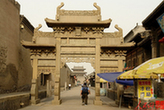The history of Chinese seals can date back to thousands of years ago. Although small in size, the seals symbolize a mysterious culture. In ancient times, the Tibetan ethnic group called the seals “Ji Hun Shi (the stone in which a spirit was reposed)” and handed them down from generation to generation. Possessing great glamour, Tibetan seals are regarded as the gem of China. As they involve the areas of history, celebrities, politics and religion in depth, as well as covering various kinds of scripts, patterns, totems, materials and craftsmanship, Tibetan seals fully reflect the profoundness of the Tibetan culture. They have played a significant role in all respects of Tibetan society. Therefore, Tibetan seal study, a new subject, deserves to be added to the flourishing Tibetan studies.
Gold seal with a lion-shaped handle, an iron seal surface and a buckskin ribbon, during the Phakmo Trupa Authority in Tibet, Ming Dynasty (1368-1644) |
History of Ancient Tibetan Seals
When did ancient Tibetan seals originate? There is no official answer due to the absence of proof. According to historical records, however, in the 7th century AD, the Tubo kingdom was already significantly developed in the fields of politics, economy, military affairs and culture. Tubo people (ancestors of Tibetan people) formed a bureaucracy and developed a full-fledged legal system. After unifying the Tibetan highlands, Tubo people had to use seals as tokens when managing a large number of subordinate tribes in the occupied territory, dispatching troops and issuing orders. It could be concluded the Tibetan ethic group began to use seals long ago.
During Yuan (1271-1368) and Ming (1368-1644) Dynasties, the handles of Tibetan seals (including royal seals used for conferring official titles, seals of the temple, Lama’s seals and noblemen’s seals) were made into the shapes of Li (colored graze), camel, dragon, lion, Fa Lun (Dharmacakra), Bao Zhu (pearl), Ru Yi (sceptre border) and elliptic cylinder.
Sapphire seal with a lion-shaped handle, a gold seal surface and an iron holder, during the Sakya Authority in Tibet, Yuan Dynasty (1271-1368) |





Why not rent a boyfriend, or girlfriend to please parents during the Spring Festival?